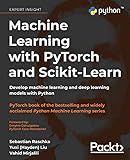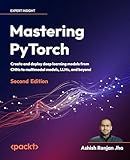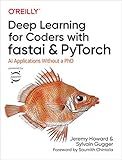Best Tools to Calculate Gradients in PyTorch to Buy in December 2025

Machine Learning with PyTorch and Scikit-Learn: Develop machine learning and deep learning models with Python



PyTorch Pocket Reference: Building and Deploying Deep Learning Models



Mastering PyTorch: Create and deploy deep learning models from CNNs to multimodal models, LLMs, and beyond



Deep Learning for Coders with fastai and PyTorch: AI Applications Without a PhD



The StatQuest Illustrated Guide to Neural Networks and AI: With hands-on examples in PyTorch!!!



The Hundred-Page Language Models Book: hands-on with PyTorch (The Hundred-Page Books)


To calculate gradients in PyTorch, you need to follow a few steps:
- Define your input tensors and ensure they have the requires_grad attribute set to True. This will allow PyTorch to track operations on these tensors and compute gradients.
- Create a computational graph by performing operations on the input tensors. PyTorch automatically tracks all the computations involved in the graph.
- After obtaining the output tensor, invoke the backward() function on it. This function triggers the computation of gradients for all the tensors involved in the computational graph.
- Finally, you can access the gradients by using the grad attribute of any tensor in the graph, which will contain the calculated gradients.
Here's an example of calculating gradients in PyTorch:
import torch
Step 1: Define input tensor and enable gradient tracking
x = torch.tensor([2.0], requires_grad=True)
Step 2: Create a computational graph
y = x**2 + 3*x + 1
Step 3: Compute gradients
y.backward()
Step 4: Access the gradients
print("Gradient of x:", x.grad)
In the above code, we first define the input tensor x with requires_grad=True to enable gradient tracking. Then we create a computational graph by defining the output tensor y using operations on x. After that, we call y.backward() to compute the gradients, and finally access the computed gradient using the grad attribute of the input tensor x.
What is the effect of activation functions on gradient calculation in PyTorch?
Activation functions play a crucial role in the gradient calculation process in PyTorch. The gradient calculation involves computing the derivative of the loss function with respect to the parameters of the model. This derivative is then used to update the model's parameters through backpropagation and optimization algorithms such as gradient descent.
The choice of activation function can affect the gradient calculation in two main ways:
- Differentiability: The activation function must be differentiable to compute the gradients effectively. PyTorch's autograd engine, which automatically computes gradients, relies on the chain rule to perform backpropagation. If an activation function is not differentiable at certain points, the gradients at those points become undefined, preventing proper gradient computation and backpropagation.
- Gradient magnitude: Activation functions can impact the magnitude of the gradients, which affects the optimization process. Some activation functions, like sigmoid and tanh, have small gradients in certain regions, which can lead to vanishing gradients. When gradients become too small, deep neural networks may struggle to learn and converge effectively. On the other hand, activation functions like ReLU have a more favorable gradient behavior, keeping gradients non-zero for positive inputs, addressing the vanishing gradient problem to an extent.
Overall, the choice of activation function can significantly influence the gradient calculation and subsequent training of deep learning models in PyTorch. It is important to select activation functions that are differentiable and mitigate issues such as vanishing or exploding gradients to achieve better training performance.
What is the purpose of calculating gradients in PyTorch?
The purpose of calculating gradients in PyTorch is to enable automatic differentiation, which is a key component of training and optimizing neural networks. Gradients represent the rate of change of a function with respect to its parameters. By computing gradients, PyTorch allows users to propagate error gradients backwards through the network, which is essential for updating the parameters using various optimization algorithms like stochastic gradient descent (SGD). This makes it easier to train deep learning models and find the optimal values for the model's parameters.
How to handle non-differentiable operations in gradient calculation with PyTorch?
PyTorch uses automatic differentiation to compute gradients, which only works on differentiable operations. However, there are scenarios where you might encounter non-differentiable operations. Here are some approaches to handle them:
- Utilize a surrogate gradient: If your non-differentiable operation appears in a small part of the overall computation graph, you can approximate its gradient using a surrogate gradient. The surrogate gradient can be a constant or a simple function that behaves similarly to the non-differentiable operation. Although this approximation may not be accurate, it allows you to continue gradient backpropagation.
- Implement a custom backward function: If the non-differentiable operation represents a crucial part of your computation graph, you can implement a custom backward function for it. By writing your own backward pass using PyTorch's autograd engine, you can manually compute the gradients for the non-differentiable operation. This approach requires a deeper understanding of the underlying mathematical operations and the ability to compute their gradients manually.
- Use a differentiable approximation: Sometimes, it is possible to find a differentiable approximation or an alternative formulation for the non-differentiable operation. This approximation might not perfectly represent the non-differentiable operation, but it allows you to still compute gradients using automatic differentiation. This approach requires careful consideration and analysis of the problem domain.
- Apply reinforcement learning techniques: If your non-differentiable operation stems from a reinforcement learning scenario, you can use techniques such as REINFORCE or the Gumbel-Softmax relaxation to backpropagate through discrete or non-differentiable decisions.
Remember that handling non-differentiable operations demands a careful choice of approximation or workaround based on the specific problem and domain.
How to find gradients using PyTorch?
To find gradients using PyTorch, you can follow these steps:
- Import the necessary modules:
import torch
- Define the tensor variable for which you want to find the gradients:
x = torch.tensor([1.0, 2.0, 3.0], requires_grad=True)
Here, requires_grad=True indicates that you want to compute gradients with respect to this tensor.
- Define a mathematical operation on the tensor x:
y = 2 * x + 1
- Create a scalar value by reducing the tensor y:
z = y.mean()
- Initialize and set the gradients to zero:
x.grad.zero_()
- Compute the gradients using the backward() method:
z.backward()
- Access the gradients using the .grad attribute of the tensor x:
print(x.grad)
Here, x.grad will provide the gradients of z with respect to x.
Note: It is important to call backward() before accessing the gradients.
By following these steps, you can find gradients for any mathematical operation or PyTorch model.
